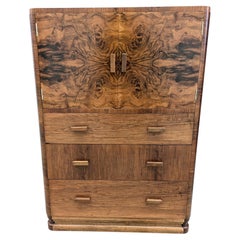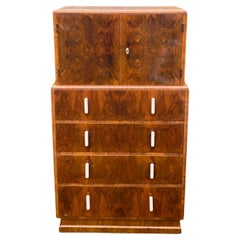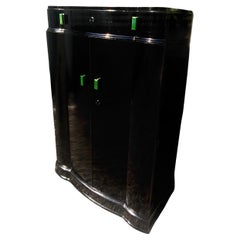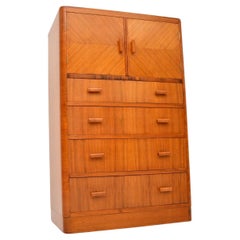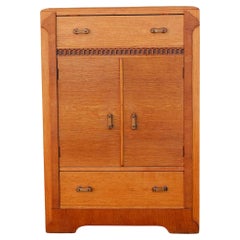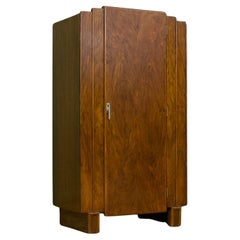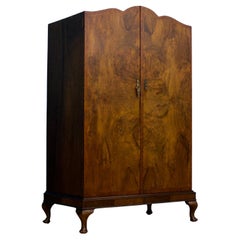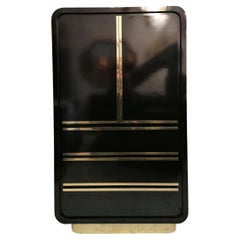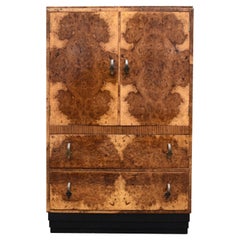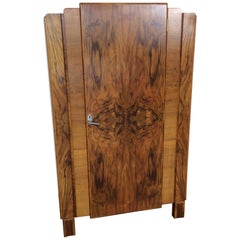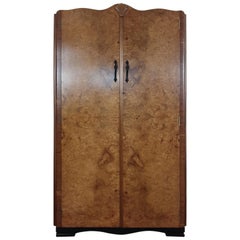Art Deco Tallboy
Vintage 1930s Art Deco Cabinets
Walnut
Mid-20th Century English Art Deco Wardrobes and Armoires
Brass
Mid-20th Century English Art Deco Wardrobes and Armoires
Brass
Vintage 1930s Art Deco Dressers
Walnut
Vintage 1930s European Art Deco Wardrobes and Armoires
Walnut
Vintage 1930s European Art Deco Wardrobes and Armoires
Walnut
Vintage 1920s British Art Deco Commodes and Chests of Drawers
Walnut
Early 20th Century English Art Deco Commodes and Chests of Drawers
Oak
Vintage 1920s British Art Deco Linen Presses
Wood, Walnut
Vintage 1930s British Art Deco Linen Presses
Wood, Walnut
Vintage 1980s American Art Deco Cabinets
Metal
Mid-20th Century English Art Deco Bedroom Sets
Brass
Vintage 1930s British Art Deco Cabinets
Wood, Birdseye Maple
Recent Sales
Vintage 1930s English Art Deco Wardrobes and Armoires
Walnut
20th Century British Art Deco Wardrobes and Armoires
Birdseye Maple
20th Century British Art Deco Wardrobes and Armoires
Walnut
20th Century British Art Deco Wardrobes and Armoires
Walnut
Vintage 1930s English Art Deco Commodes and Chests of Drawers
Walnut
20th Century English Art Deco Bedroom Sets
Aluminum
Vintage 1930s British Art Deco Cabinets
Wood, Walnut
Vintage 1930s English Art Deco Blanket Chests
Metal
Vintage 1930s British Art Deco Cupboards
Walnut
Vintage 1930s English Art Deco Commodes and Chests of Drawers
Walnut
Vintage 1930s European Art Deco Wardrobes and Armoires
Walnut
Vintage 1930s British Art Deco Wardrobes and Armoires
Walnut
Mid-20th Century European Art Deco Wardrobes and Armoires
Oak, Walnut
Vintage 1930s French Art Deco Cabinets
Rosewood
Vintage 1930s European Art Deco Bedroom Sets
Walnut
Mid-20th Century English Art Deco Bedroom Sets
Macassar, Walnut
Vintage 1930s British Art Deco Cupboards
Wood, Oak
Early 20th Century English Art Deco Cabinets
Walnut
Mid-20th Century English Art Deco Linen Presses
Walnut
Vintage 1930s British Art Deco Wardrobes and Armoires
Wood, Walnut
Vintage 1930s English Art Deco Wardrobes and Armoires
Walnut
Vintage 1930s British Art Deco Linen Presses
Walnut
Vintage 1950s British Art Deco Linen Presses
Wood, Walnut
Vintage 1930s English Art Deco Commodes and Chests of Drawers
Brass, Copper
Vintage 1930s British Art Deco Wardrobes and Armoires
Wood, Walnut
Vintage 1930s British Art Deco Commodes and Chests of Drawers
Wood, Oak
Vintage 1930s English Art Deco Commodes and Chests of Drawers
Walnut
Vintage 1940s British Art Deco Linen Presses
Wood, Walnut
Vintage 1930s British Art Deco Linen Presses
Wood, Walnut
Vintage 1930s British Art Deco Cupboards
Wood, Walnut
Early 20th Century English Art Deco Wardrobes and Armoires
Maple, Walnut
Vintage 1920s British Art Deco Wardrobes and Armoires
Wood, Walnut
Vintage 1930s British Art Deco Wardrobes and Armoires
Wood, Walnut
Vintage 1930s British Art Deco Cabinets
Birdseye Maple, Wood
Mid-20th Century British Art Deco Cabinets
Wood, Walnut, Beech
Mid-20th Century American Art Deco Dressers
Mahogany
Vintage 1930s British Art Deco Wardrobes and Armoires
Wood, Walnut
Early 20th Century Czech Art Deco Wardrobes and Armoires
Beech, Oak, Walnut
Vintage 1930s British Art Deco Wardrobes and Armoires
Wood, Walnut
Vintage 1950s British Art Deco Wardrobes and Armoires
Wood, Walnut
Vintage 1930s British Art Deco Cabinets
Wood, Walnut
Vintage 1930s British Art Deco Cabinets
Wood, Walnut
Vintage 1920s English Art Deco Cabinets
Mirror, Burl
Vintage 1930s English Art Deco Cupboards
Oak
Vintage 1930s British Art Deco Wardrobes and Armoires
Walnut
Vintage 1930s European Art Deco Cupboards
Walnut
20th Century English Art Deco Commodes and Chests of Drawers
Leather
20th Century English Art Deco Commodes and Chests of Drawers
Wood
Vintage 1930s British Art Deco Wardrobes and Armoires
Wood, Walnut
Vintage 1930s British Art Deco Wardrobes and Armoires
Wood, Walnut
Early 20th Century English Art Deco Commodes and Chests of Drawers
Oak
Vintage 1940s Art Deco Commodes and Chests of Drawers
Walnut
Vintage 1930s British Art Deco Cabinets
Wood, Walnut
Mid-20th Century English Art Deco Bedroom Sets
Macassar, Mahogany, Walnut
Vintage 1930s French Art Deco Wardrobes and Armoires
Walnut
Vintage 1930s European Art Deco Wardrobes and Armoires
Walnut
Mid-20th Century English Art Deco Wardrobes and Armoires
Brass
Mid-20th Century English Art Deco Wardrobes and Armoires
Brass
Vintage 1920s Art Deco Wardrobes and Armoires
Walnut
20th Century British Commodes and Chests of Drawers
Hardwood
People Also Browsed
2010s American Modern Wall Lights and Sconces
Nickel, Bronze, Brass
21st Century and Contemporary Swedish Mid-Century Modern Table Lamps
Textile
2010s South African Minimalist Night Stands
Poplar, Burl
Mid-20th Century English Art Deco Wardrobes and Armoires
Walnut
Mid-20th Century English Art Deco Desks
Bakelite, Walnut
20th Century British Wardrobes and Armoires
Walnut
20th Century American Art Deco Wardrobes and Armoires
Wood, Maple, Birdseye Maple, Burl
20th Century British Wardrobes and Armoires
Walnut
Mid-20th Century English Art Deco Bedroom Sets
Mirror, Walnut
Vintage 1930s English Art Deco Wardrobes and Armoires
Walnut
Mid-20th Century English Art Deco Beds and Bed Frames
Iron
Vintage 1930s Czech Bauhaus Wardrobes and Armoires
Chrome
Vintage 1940s English Art Deco Wardrobes and Armoires
Walnut
Vintage 1930s Czech Art Deco Wardrobes and Armoires
Wood, Walnut
2010s Italian Wardrobes and Armoires
Walnut
Vintage 1930s British Art Deco Wardrobes and Armoires
Wood, Walnut
Art Deco Tallboy For Sale on 1stDibs
How Much is a Art Deco Tallboy?
A Close Look at Art Deco Furniture
Art Deco furniture is characterized by its celebration of modern life. More than its emphasis on natural wood grains and focus on traditional craftsmanship, vintage Art Deco dining chairs, tables, desks, cabinets and other furniture — which typically refers to pieces produced during the 1920s and 1930s — is an ode to the glamour of the “Roaring Twenties.”
ORIGINS OF ART DECO FURNITURE DESIGN
- Emerged in the 1920s
- Flourished while the popularity of Art Nouveau declined
- Term derives from 1925’s Exposition Internationale des Arts Décoratifs et Industriels Modernes (International Exhibition of Modern Decorative and Industrial Arts) in Paris, France
- Informed by Ancient Egypt, Cubism, Futurism, Louis XVI, De Stijl, modernism and the Vienna Secession; influenced Streamline Moderne and mid-century modernism
CHARACTERISTICS OF ART DECO FURNITURE DESIGN
- Bold geometric lines and forms, floral motifs
- Use of expensive materials such as shagreen or marble as well as exotic woods such as mahogany, ebony and zebra wood
- Metal accents, shimmering mirrored finishes
- Embellishments made from exotic animal hides, inlays of mother-of-pearl or ivory
ART DECO FURNITURE DESIGNERS TO KNOW
VINTAGE ART DECO FURNITURE ON 1STDIBS
Few design styles are as universally recognized and appreciated as Art Deco. The term alone conjures visions of the Roaring Twenties, Machine Age metropolises, vast ocean liners, sleek typography and Prohibition-era hedonism. The iconic movement made an indelible mark on all fields of design throughout the 1920s and ’30s, celebrating society’s growing industrialization with refined elegance and stunning craftsmanship.
Widely known designers associated with the Art Deco style include Émile-Jacques Ruhlmann, Eileen Gray, Maurice Dufrêne, Paul Follot and Jules Leleu.
The term Art Deco derives from the name of a large decorative arts exhibition held in Paris in 1925. “Art Deco design” is often used broadly, to describe the work of creators in associated or ancillary styles. This is particularly true of American Art Deco, which is also called Streamline Moderne or Machine Age design. (Streamline Moderne, sometimes known as Art Moderne, was a phenomenon largely of the 1930s, post–Art Nouveau.)
Art Deco textile designers employed dazzling floral motifs and vivid colors, and while Art Deco furniture makers respected the dark woods and modern metals with which they worked, they frequently incorporated decorative embellishments such as exotic animal hides as well as veneers in their seating, case pieces, living room sets and bedroom furniture.
From mother-of-pearl inlaid vitrines to chrome aviator chairs, bold and inventive works in the Art Deco style include chaise longues (also known as chaise lounges) and curved armchairs. Today, the style is still favored by interior designers looking to infuse a home with an air of luxury and sophistication.
The vintage Art Deco furniture for sale on 1stDibs includes dressers, coffee tables, decorative objects and more.
Finding the Right Case Pieces And Storage Cabinets for You
Of all the vintage storage cabinets and antique case pieces that have become popular in modern interiors over the years, dressers, credenzas and cabinets have long been home staples, perfect for routine storage or protection of personal items.
In the mid-19th century, cabinetmakers would mimic styles originating in the Louis XIV, Louis XV and Louis XVI eras for their dressers, bookshelves and other structures, and, later, simpler, streamlined wood designs allowed these “case pieces” or “case goods” — any furnishing that is unupholstered and has some semblance of a storage component — to blend into the background of any interior.
Mid-century modern furniture enthusiasts will cite the tall modular wall units crafted in teak and other sought-after woods of the era by the likes of George Nelson, Poul Cadovius and Finn Juhl. For these highly customizable furnishings, designers of the day delivered an alternative to big, heavy bookcases by considering the use of space — and, in particular, walls — in new and innovative ways. Mid-century modern credenzas, which, long and low, evolved from tables that were built as early as the 14th century in Italy, typically have no legs or very short legs and have grown in popularity as an alluring storage option over time.
Although the name immediately invokes images of clothing, dressers were initially created in Europe for a much different purpose. This furnishing was initially a flat-surfaced, low-profile side table equipped with a few drawers — a common fixture used to dress and prepare meats in English kitchens throughout the Tudor period. The drawers served as perfect utensil storage. It wasn’t until the design made its way to North America that it became enlarged and equipped with enough space to hold clothing and cosmetics. The very history of case pieces is a testament to their versatility and well-earned place in any room.
In the spirit of positioning your case goods center stage, decluttering can now be design-minded.
A contemporary case piece with open shelving and painted wood details can prove functional as a storage unit as easily as it can a room divider. Alternatively, apothecary cabinets are charming case goods similar in size to early dressers or commodes but with uniquely sized shelving and (often numerous) drawers.
Whether you’re seeking a playful sideboard that features colored glass and metal details, an antique Italian hand-carved storage cabinet or a glass-door vitrine to store and show off your collectibles, there are options for you on 1stDibs.
- What is the history of Art Deco?1 Answer1stDibs ExpertMarch 25, 2024The history of Art Deco begins in the early 20th century.
Art Deco emerged as a global design style around the start of World War I, during the last years of Art Nouveau's popularity. The style conjures visions of the Roaring Twenties, Machine Age metropolises, vast ocean liners, sleek typography and Prohibition-era hedonism. Its hallmarks include the use of geometric designs influenced by Cubism. Major discoveries of Egyptian tombs during the era also influenced the movement.
The term Art Deco derives from the name of a large decorative arts exhibition, the Exposition Internationale des Arts Décoratifs et Industriels Modernes, held in Paris in 1925. After World War II, tastes shifted toward more functional, less ornate modernism, but today, the Art Deco style is still favored for its luxurious sophistication. On 1stDibs, shop a large selection of vintage Art Deco furniture. - How do I identify Art Deco?1 Answer1stDibs ExpertApril 5, 2022To identify Art Deco, look for the characteristics of the period. Furniture produced at the time is generally lacquered metal with a mirror-like glossy finish. Wooden items should be an exotic wood. Most items feature symmetrical designs, and geometric forms were popular motifs during the period. In addition, Art Deco often shows the influence of Hellenistic, Egyptian and Asian designs. Shop a variety of Art Deco furniture and decorative objects on 1stDibs.
- When did Art Deco originate?1 Answer1stDibs ExpertFebruary 1, 2024The Art Deco period originated in France. Its name comes from the title of a large decorative arts exhibition held in Paris in 1925, credited with introducing the style to the world. It was informed by ancient Egypt, Cubism, Futurism, Louis XVI, De Stijl, modernism and the Vienna Secession and went on to influence the Streamline Moderne and mid-century modern movements. Shop a wide range of Art Deco furniture, decorative objects and jewelry on 1stDibs.
- What defines Art Deco?1 Answer1stDibs ExpertApril 5, 2024A few things define Art Deco. Date is one factor, as the style emerged in the 1920s and remained popular during the 1930s. Art Deco design usually includes bold geometric lines and forms or intricate repeating floral motifs. Designers working in this style tended to use expensive materials, such as shagreen or marble, as well as exotic woods like mahogany, ebony and zebra wood. Furniture often featured metal accents, mirrored finishes and embellishments made from exotic animal hides and inlays of mother-of-pearl or ivory. Shop a wide range of Art Deco furniture on 1stDibs.
- What was Art Deco influenced by?1 Answer1stDibs ExpertMay 3, 2024Art Deco was influenced by a number of things. The discovery of ancient tombs around the turn of the century led to a renewed interest in Egyptian furniture and architecture that inspired Art Deco designers. Art Deco was also informed by Cubism, Futurism, Louis XVI style, De Stijl, modernism and the Vienna Secession. Shop a large collection of Art Deco furniture, decorative objects and jewelry on 1stDibs.
- What is art deco ring?1 Answer1stDibs ExpertAugust 17, 2021Art Deco rings were made during the early 20th century. Named for a design movement that originated at a large decorative arts exhibition held in Paris in 1925, Art Deco rings are generally quite geometric, symmetrical and incorporate a variety of gemstones — especially sapphires and emeralds. Find a wide variety of Art Deco rings for sale on 1stDibs.
- What is an Art Deco lamp?1 Answer1stDibs ExpertApril 5, 2022An Art Deco lamp is any lamp that’s made in the styles of the Art Deco movement, which was dominant in the 1920s and 1930s. On 1stDibs, you’ll find a collection of Art Deco lamps from some of the world’s top sellers.
- What was the Art Deco movement?1 Answer1stDibs ExpertMay 30, 2024The Art Deco movement was a decorative style popular during the 1920s and ’30s. Few design styles are as universally recognized and appreciated as Art Deco. The term alone conjures visions of the Roaring Twenties, Machine Age metropolises, vast ocean liners, sleek typography and Prohibition-era hedonism. The iconic movement made an indelible mark on all fields of design, celebrating society's growing industrialization with refined elegance and stunning craftsmanship. Widely known designers associated with the Art Deco style include Émile-Jacques Ruhlmann, Eileen Gray, Maurice Dufrêne, Paul Follot and Jules Leleu. The term Art Deco derives from the name of a large decorative arts exhibition held in Paris in 1925. On 1stDibs, shop a wide range of Art Deco furniture and decorative objects.
- What is an art deco watch?1 Answer1stDibs ExpertApril 5, 2022An art deco watch is defined by its geometric case, which is either circular or rectangular. The watch style was highly popular between 1920 and 1950, and is still sought after today. You’ll find a collection of art deco watches from some of the world’s top sellers on 1stDibs
- What is art deco jewelry?1 Answer1stDibs ExpertFebruary 22, 2021Art Deco jewelry was popular during the design movement of the 1920s and 30s. Art Deco jewelry is typically characterized by geometric patterns and gemstones of contrasting colors.
- 1stDibs ExpertAugust 15, 2019
The main difference between Art Nouveau and Art Deco is that the former is detailed and ornate, and the latter is sharp and geometrical. When the movement started at the end of the 19th century, Art Nouveau was heavily influenced by nature and the curved lines of flowers. Art Deco, which became popular in the beginning of the 20th century, was inspired by the geometric abstraction of cubism.
- 1stDibs ExpertAugust 26, 2024The difference between Art Deco and mid-century modern (MCM) is that the terms describe two distinct design styles. Art Deco typically refers to pieces produced between the 1920s and 1930s. Furniture produced in this style tends to display bold geometric lines and forms, floral motifs, metal accents, shimmering mirrored finishes and embellishments made from exotic animal hides, inlays of mother-of-pearl or ivory. MCM, or mid-century modern, emerged after World War II. Organically shaped, clean-lined and elegantly simple are three terms that well describe vintage mid-century modern furniture. Designers working in this style frequently used industrial materials, including steel, fiberglass, molded plywood, and alluring woods such as teak, rosewood and oak. Explore a wide variety of Art Deco and mid-century modern furniture on 1stDibs.
- 1stDibs ExpertFebruary 13, 2023To know if a ring is Art Deco, examine its style. The Art Deco period, encompassing the 1920s and ’30s, ushered in a very distinct look in the design of jewelry. Makers often incorporated geometric motifs in jewelry designs. Materials may also provide a clue about the era of the piece. Platinum, rubies, sapphires and emeralds were some of the most common precious metals and gemstones used at the time. Keep in mind that there are many convincing reproductions of Art Deco rings and other high-quality pieces inspired by originals. As a result, you may wish to have a certified appraiser or expert within the field of antique jewelry design to evaluate the ring. Shop a selection of Art Deco rings on 1stDibs.
- 1stDibs ExpertFebruary 27, 2024To identify Art Deco furniture, first look for maker's markings in inconspicuous areas. Once you've found them, use trusted online resources to research the manufacturer and determine whether they were active during the Art Deco era, which spanned from the 1920s through the 1930s. You can also look for classic characteristics of Art Deco furniture, such as bold geometric lines and forms, intricate floral motifs, metal accents, mirrored finishes and fine materials such as shagreen, marble, mahogany wood, zebra wood, ebony, exotic animal hides, onyx and mother-of-pearl. A certified appraiser or knowledgeable antiques dealer can also assist you with making identifications. Shop a collection of Art Deco furniture on 1stDibs.
- Is Art Deco jewelry valuable?1 Answer1stDibs ExpertFebruary 1, 2024Yes, some Art Deco jewelry is valuable. Jewelry from the 1920s and ’30s has remained consistently popular. It experienced a major revival in the 1960s, and even today, jewelry makers continue to be inspired by the period. As a result, demand for Art Deco jewelry is typically high, but the actual value of a piece depends on its style, maker, age and condition. A certified appraiser or experienced antiques dealer can help you determine how much your jewelry is worth. Explore a large selection of Art Deco jewelry on 1stDibs.
- Was Eileen Gray Art Deco?1 Answer1stDibs ExpertFebruary 21, 2024The answer to whether Eileen Gray's designs were Art Deco depends on which piece you're considering. Gray was ever-evolving as a designer. By the early 1920s, she was creating geometric works that embodied the essence of Art Deco and the nascent modernist design movement. Some pieces, like her Bricks screen, employ the planar forms favored by Gerrit Rietveld and other De Stijl architects of the Netherlands. Others feature the tubular chrome framing used by Marcel Breuer and Ludwig Mies van der Rohe, who are associated with the mid-century modern design style. On 1stDibs, shop a variety of Eileen Gray furniture.
- 1stDibs ExpertAugust 15, 2019
The main features of Art Deco are geometry-influenced shapes, bright color schemes and bold patterns. Art Deco architecture and design are both heavily influenced by the Cubism movement, which relied on the use of non-traditional angles and shapes.
- 1stDibs ExpertSeptember 25, 2019
Art Deco features bold geometric designs, clean lines and vibrant colors.
- How was Art Deco furniture made?1 Answer1stDibs ExpertApril 5, 2022Art Deco furniture was largely made by hand. Crafters often employed exotic hardwood like zebra wood, rosewood and Macassar ebony. Many pieces had a polished Japanese lacquer finish, which gave a high-gloss shine to the wood. On 1stDibs, shop a variety of Art Deco furniture.
- 1stDibs ExpertNovember 8, 2023Art Deco engagement rings are accessories that were produced during the 1920s and '30s and are characterized by details associated with the Art Deco style. They're often very colorful and feature bold geometric lines as well as gemstones cut in nontraditional ways. While the style got its name from an arts exhibition in Paris in 1925, Art Deco was inspired by Cubism and a shift from Art Nouveau's floral aesthetic. The modern look of Art Deco engagement rings reflects an evolution in fashion, visual art and more, as well as the sweeping societal changes taking hold at the time. On 1stDibs, shop a range of vintage Art Deco engagement rings.


